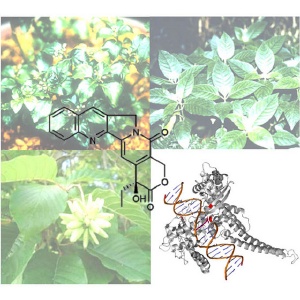Aug 29 2008
Japanese researchers have explained the mechanism of self-resistance in plants to their own lethal toxins. This new information will help medical researchers to tackle resistance in humans to anticancer drugs that are often based on these plant toxins.
 Three plant species producing camptothecin and its interaction with DNA and topoisomerase I.
Three plant species producing camptothecin and its interaction with DNA and topoisomerase I.
Camptothecin (CPT) is a plant-derived anticancer drug that kills cancerous cells by disrupting the action of an enzyme called topoisomerase 1 (Top1), which is essential to DNA maintenance in almost all living organisms. Although CPT is deadly to most life forms, resistance to the toxin is found in its source plants and in some CPT-treated human cancer cells.
Now Kazuki Saito of the RIKEN Plant Science Center in Yokohama and his team from Chiba University and the Japan Science and Technology Agency in Chiba, have shown for the first time how plant self-resistance works at a molecular level. Understanding these processes is becoming increasingly important because of the expanding use of plant-derived compounds as medicines and the evolving drug resistance in the human cells they are used to target.
By comparing Top1 genes from CPT-producing and non-producing plants, the team found three mutations in the toxin producers that cause amino acid changes in the resulting enzyme and make it immune to the drug’s poisonous attack. Remarkably, one of the amino acid substitutions found by Saito and his colleagues in plants is identical to one that has been found previously in CPT-resistant human cancer cells.
The team’s genetic comparisons, reported recently in the Proceedings of the National Academy of Sciences1, suggest that CPT resistance in the source plant has developed gradually in parallel with the ability to produce the drug. Consequently, the team proposes that low-level CPT production may have triggered the resistance-giving mutation to occur in Top1. The importance of this suggestion is exemplified by the observation that continuous exposure of human cancer cells to CPT results in a Top1 mutation conferring CPT resistance.
The team’s findings will help to uncover similar self-resistance mechanisms in other plants and for different toxins. Furthermore, understanding the molecular interaction between cancer drugs and their target molecules will facilitate the design of drug therapies that prevent resistance in their human targets. Saito’s team intends to explore CPT biosynthesis with a view to the feasible production of anticancer compounds. They also “look forward to establishing the evolutionary genomic basis of chemical diversity in plants through the study of plant toxins,” says Saito.